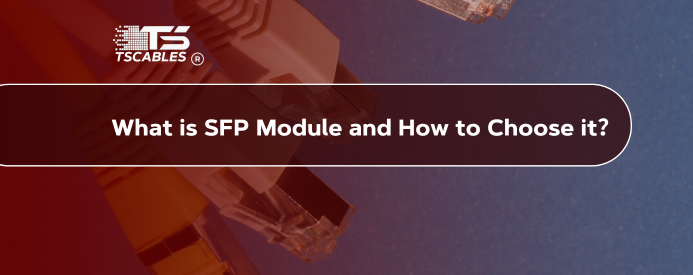An SFP module plugs into your network gear and links switches, routers, or servers. It’s small but powerful. You might see ports labelled “SFP port for fiber” or “SFP optical connector.” These let you add versatility where you can use a mix of copper or fiber without replacing equipment.
However, choosing the right one can be tricky. There are different kinds of SFP fiber modules, speeds, brands, and prices. This guide walks you through the basics and will tell you everything, from what SFP is to how to pick the right SFP module. In the end, you'll feel confident plugging in the proper SPF connector.
SFP Fiber Module Overview and Functionality
An SFP fiber module is sometimes called a mini-GBIC, and it is a hot-swappable device. You insert it into an SFP port on networking gear. Once connected, it sends data over fiber optic or copper cables. It converts electrical signals to light or electric pulses. As a result, it can enable fast, flexible network setups.
These modules work across different equipment and brands. The SFP in the networking world is all about choice: different speeds, connectors, and distances. For example, if your device only has copper Ethernet ports, then you can use an SFP fiber module to connect to fiber lines. That choice adds speed and range without changing your hardware.
Ethernet SFP Module: What Is It?
An Ethernet SFP module lets Ethernet cables plug into devices with SFP ports. You slide the module into the port. Then it acts like a miniature interface. It carries the same Ethernet signals but through a different connector. This allows you to adapt your device for other types of cabling, like fiber.
These modules come rated for speeds like 1 Gbps or 10 Gbps, and they also fit various fiber types. If patching high-bandwidth links, an Ethernet SFP module gives you flexibility. It lets you use existing SFP-ready equipment with different cable choices.
Considerations for Selecting an Ethernet SFP Module
Choosing the right SFP cord involves more than matching speed. You must think about equipment, usage, and reliability. First, make sure your device accepts the same module type. Then ask whether to buy new or used. Price matters, but not at the expense of performance.
Also, check if the module handles your expected temperature range. These factors together lead to a smooth setup and a longer lifespan. Other than that, you also need to keep an eye on the following things:
Compatibility
Not all modules work with every brand. Some switches only accept specific SFP fiber module vendors. Before choosing, check your switch or router's manual. Using an incompatible part could lead to poor connection or errors.
New or Second-Hand
New modules are more expensive, but come with a warranty and fresh parts. On the other hand, used or off-brand modules cost less. They might work well, but reliability varies. If you go second-hand, test each one and choose the one that helps avoid connection issues later.
Price
Prices vary widely. OEM-branded SFP modules can be pricey. Third-party modules offer budget-friendly options. Check specs and warranty. A cheaper module may save money now, but cost you more in downtime or replacements.
Temperature Stability
Data gear runs hot, and that is why Fiber modules must work in varying temperatures. Industrial-grade modules run in colder or hotter environments. Lower-cost modules might fail if used in heated cabinets. Ensure your cartridge handles your specific environment.
How to Choose the Right SFP Module?
Choosing the right SFP in networking gear depends on several needs. You need to think about cable type, speed, vendor compatibility, and future plans. Before you shop, answer these questions:
- Will you use copper or fiber?
- Do you need high speed beyond 1 Gbps?
- Will the module stay in standard racks or harsher conditions?
By clarifying your needs, you get the right SFP optical connector and avoid mismatches. Having the right plan makes installation and daily operation smoother.
SFP Copper or Fiber Module: Which One to Choose?
Copper SFP modules use RJ45 ports like regular Ethernet. These work well for patching within racks or short runs. Fiber SFP uses glass for longer runs and better signal quality. Fiber also resists electrical noise. Choose copper if you're close, or choose fiber for long cable runs or interference-prone areas.
SFP or Advanced SFP+: Which One to Choose?
An SFP vs. Ethernet choice often means choosing between SFP and SFP+. SFP supports up to 1 Gbps. SFP+ handles up to 10 Gbps and fits in the same slot. You need better cable and powered hardware for SFP+. If your network is growing fast, SFP+ offers future-proof speed. For smaller needs, standard SFP is fine and cheaper.
MSA Compatible SFP or Not: Which One To Choose?
Multisource Agreement (MSA) ensures compatibility between vendors. An MSA-certified module works across brand devices. Proprietary modules may be cheaper, but they risk lock-in or lock-out problems. Buy MSA modules to ensure smoother network builds and fewer surprises.
Conclusion
SFP modules bring flexibility to your network by adding fiber or copper links without replacing hardware. Choose based on compatibility, speed, cable type, and environment. The right SFP connector makes your network more adaptable and reliable. TS Cables offers quality SFP modules that fit your setup and budget.
FAQs
Can any SFP fit any switch?
No. Switches often require specific or MSA-compatible modules. Always verify vendor compatibility before buying or installing.
What cable works with SFP modules?
Ethernet SFP uses copper (Cat5e/Cat6). Fiber SFP uses single- or multi-mode fiber optic cables.
Is copper SFP slower than fiber?
Yes. Copper (1 Gbps) is slower and shorter range. Fiber offers longer reach and less signal loss.
Can I mix SFP and SFP+ in one switch?
Most switches accept both if labeled “combo” or “dual rate.” Check hardware specs to confirm.
Do SFP modules have warranties?
New OEM and MSA modules include warranties. Off-brand or used units may not, so check before purchase.






